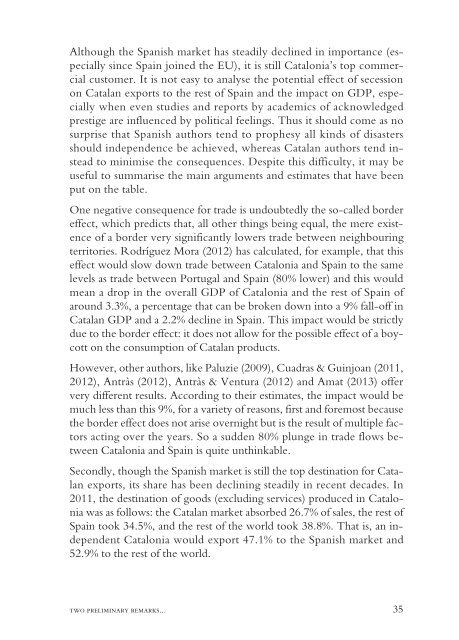The Economy of Catalonia
the_economy_of_catalonia._questions_and_answers_on_the_economic_impact_of_independence
the_economy_of_catalonia._questions_and_answers_on_the_economic_impact_of_independence
You also want an ePaper? Increase the reach of your titles
YUMPU automatically turns print PDFs into web optimized ePapers that Google loves.
Although the Spanish market has steadily declined in importance (especially<br />
since Spain joined the EU), it is still <strong>Catalonia</strong>’s top commercial<br />
customer. It is not easy to analyse the potential effect <strong>of</strong> secession<br />
on Catalan exports to the rest <strong>of</strong> Spain and the impact on GDP, especially<br />
when even studies and reports by academics <strong>of</strong> acknowledged<br />
prestige are influenced by political feelings. Thus it should come as no<br />
surprise that Spanish authors tend to prophesy all kinds <strong>of</strong> disasters<br />
should independence be achieved, whereas Catalan authors tend instead<br />
to minimise the consequences. Despite this difficulty, it may be<br />
useful to summarise the main arguments and estimates that have been<br />
put on the table.<br />
One negative consequence for trade is undoubtedly the so-called border<br />
effect, which predicts that, all other things being equal, the mere existence<br />
<strong>of</strong> a border very significantly lowers trade between neighbouring<br />
territories. Rodríguez Mora (2012) has calculated, for example, that this<br />
effect would slow down trade between <strong>Catalonia</strong> and Spain to the same<br />
levels as trade between Portugal and Spain (80% lower) and this would<br />
mean a drop in the overall GDP <strong>of</strong> <strong>Catalonia</strong> and the rest <strong>of</strong> Spain <strong>of</strong><br />
around 3.3%, a percentage that can be broken down into a 9% fall-<strong>of</strong>f in<br />
Catalan GDP and a 2.2% decline in Spain. This impact would be strictly<br />
due to the border effect: it does not allow for the possible effect <strong>of</strong> a boycott<br />
on the consumption <strong>of</strong> Catalan products.<br />
However, other authors, like Paluzie (2009), Cuadras & Guinjoan (2011,<br />
2012), Antràs (2012), Antràs & Ventura (2012) and Amat (2013) <strong>of</strong>fer<br />
very different results. According to their estimates, the impact would be<br />
much less than this 9%, for a variety <strong>of</strong> reasons, first and foremost because<br />
the border effect does not arise overnight but is the result <strong>of</strong> multiple factors<br />
acting over the years. So a sudden 80% plunge in trade flows between<br />
<strong>Catalonia</strong> and Spain is quite unthinkable.<br />
Secondly, though the Spanish market is still the top destination for Catalan<br />
exports, its share has been declining steadily in recent decades. In<br />
2011, the destination <strong>of</strong> goods (excluding services) produced in <strong>Catalonia</strong><br />
was as follows: the Catalan market absorbed 26.7% <strong>of</strong> sales, the rest <strong>of</strong><br />
Spain took 34.5%, and the rest <strong>of</strong> the world took 38.8%. That is, an independent<br />
<strong>Catalonia</strong> would export 47.1% to the Spanish market and<br />
52.9% to the rest <strong>of</strong> the world.<br />
two preliminary remarks... 35


